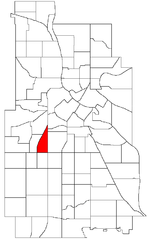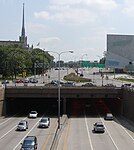Temple Israel (Minneapolis)
Jews and Judaism in Minneapolis–Saint PaulMoorish Revival architecture in MinnesotaMoorish Revival synagoguesNeoclassical synagoguesReform synagogues in Minnesota ... and 1 more
Religious organizations established in 1878

Temple Israel is a Reform Jewish synagogue in Minneapolis, Minnesota. Founded in 1878, it is the oldest synagogue in Minneapolis and one of the largest Jewish congregations in the United States.
Excerpt from the Wikipedia article Temple Israel (Minneapolis) (License: CC BY-SA 3.0, Authors, Images).Temple Israel (Minneapolis)
Emerson Avenue South, Minneapolis Calhoun Isles
Geographical coordinates (GPS) Address Website External links Nearby Places Show on map
Geographical coordinates (GPS)
| Latitude | Longitude |
|---|---|
| N 44.959525 ° | E -93.295002777778 ° |
Address
Temple Israel
Emerson Avenue South 2324
55405 Minneapolis, Calhoun Isles
Minnesota, United States
Open on Google Maps







